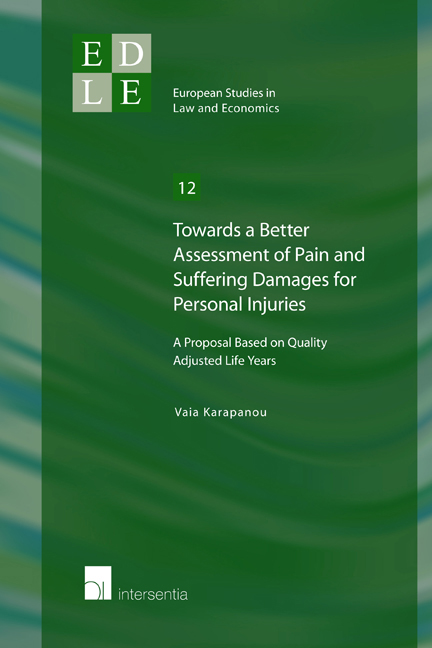 Towards a Better Assessment of Pain and Suffering Damages for Personal Injuries
Towards a Better Assessment of Pain and Suffering Damages for Personal Injuries Book contents
- Frontmatter
- Acknowledgements
- Contents
- Table of Cases
- List of Abbreviations
- List of Tables and Figures
- Chapter 1 Introduction
- Chapter 2 How Should Pain and Suffering Damages be Assessed? A Legal Perspective
- Chapter 3 How Should Pain and Suffering Damages be Assessed? A Law and Economics Perspective
- Chapter 4 Quality Adjusted Life Years. A Measure for the Economic Evaluation of Health Care
- Chapter 5 Using QALYs in a Tort Law Context. Assessing Pain and Suffering Damages
- Chapter 6 Pain and Suffering Damages Based on QALYs. Circumventing Victims' (and Judges') Hedonic Misperceptions
- Chapter 7 The QALY Framework Applied. Practical Examples and Implementation Recommendations
- Chapter 8 Epilogue
- Bibliography
- About the author
- EUROPEAN STUDIES IN LAW AND ECONOMICS
Chapter 3 - How Should Pain and Suffering Damages be Assessed? A Law and Economics Perspective
Published online by Cambridge University Press: 22 November 2017
- Frontmatter
- Acknowledgements
- Contents
- Table of Cases
- List of Abbreviations
- List of Tables and Figures
- Chapter 1 Introduction
- Chapter 2 How Should Pain and Suffering Damages be Assessed? A Legal Perspective
- Chapter 3 How Should Pain and Suffering Damages be Assessed? A Law and Economics Perspective
- Chapter 4 Quality Adjusted Life Years. A Measure for the Economic Evaluation of Health Care
- Chapter 5 Using QALYs in a Tort Law Context. Assessing Pain and Suffering Damages
- Chapter 6 Pain and Suffering Damages Based on QALYs. Circumventing Victims' (and Judges') Hedonic Misperceptions
- Chapter 7 The QALY Framework Applied. Practical Examples and Implementation Recommendations
- Chapter 8 Epilogue
- Bibliography
- About the author
- EUROPEAN STUDIES IN LAW AND ECONOMICS
Summary
Identifying the goals of a branch of law is an important task. Clear and coherent goals allow the content of both legal rules and court judgments to be formulated in a way that facilitates their attainment. The previous chapter illustrated that, according to traditional legal theory, tort law serves a plurality of goals. Of these, compensation and satisfaction are widely accepted as being most relevant when the result of a tort is personal injury. They provide guidance as to how losses arising from personal injury should be treated and, particularly with respect to immaterial losses, how pain and suffering damages should be set in order to achieve these goals.
The conclusion drawn from the preceding analysis is that in order to attain compensation and satisfaction, the damages awarded for pain and suffering in cases of personal injury should be determined on the basis of criteria pertaining to the resulting immaterial effects of the injury, namely the reduction in health and quality of life. To assess these effects, the severity and duration of the injury in combination with the age as well as other special characteristics of the victim at hand, should be taken into consideration. Unfortunately, as noted previously, despite being accepted by legal systems as the main elements for determining pain and suffering damages, these criteria are not always explicitly incorporated as such and subsequently not clearly reflected in court decisions. To the extent that judicial adjudication on damages fails to take into consideration the reduction in health and quality of life resulting from a personal injury, it may also be unsuccessful in accomplishing the goals of compensation and satisfaction.
Having investigated the goals of tort law and the subsequently emerging criteria for assessing pain and suffering damages, as these are stipulated by traditional legal theory, the analysis now turns to law and economics. The following sections present the goals of tort law as accepted by economic analysis, in order to provide the underlying rationale that should permeate the assessment of damages for immaterial losses. These goals provide a measure of judgment regarding the competence of current and hereafter proposed methods of damage assessment to attain them.
- Type
- Chapter
- Information
- Towards a Better Assessment of Pain and Suffering Damages for Personal InjuriesA Proposal Based on Quality Adjusted Life Years, pp. 39 - 68Publisher: IntersentiaPrint publication year: 2014


